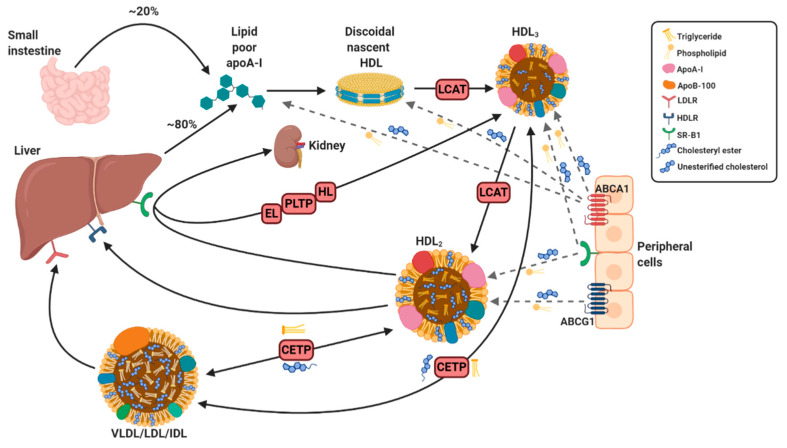Figure 1.
Simplified overview of HDL synthesis and metabolism. The liver and intestines produce apoA-I which becomes discoidal nascent HDL after interaction with ATP-binding cassette transporter A1 (ABCA1). Lipidation of discoidal nascent HDL with unesterified cholesterol and phospholipids via ABCA1, ABCG1, and scavenger receptor B type 1 (SR-B1) and cholesterol esterification via lecithin-cholesterol acyltransferase (LCAT) produces spherical HDL3 and further lipidation results in HDL2 (only representative cross sections shown). Cholesterol is transported to the liver directly from HDL2 via a not yet identified HDL receptor (HDLR) or through binding with SR-B1 (to be excreted by kidneys) or indirectly via interaction of very-low-density lipoprotein (VLDL), low-density lipoprotein (LDL), and intermediate-density lipoprotein (IDL) with LDL receptor (LDLR) following uptake of cholesterol and triglycerides from HDL2, which is facilitated by cholesterol ester transfer protein (CETP). Recycling of HDL2 occurs by the remodeling into lipid-poor and denser HDL3 catalyzed by endothelial lipase (EL), hepatic lipase (HL), and phospholipid transfer protein (PLTP), which can once again undergo further lipidation. Solid arrows refer to specific steps in HDL metabolism and maturation, while dotted arrows reflect the transfer of triglycerides and unesterified cholesterol from peripheral cells to specific particles by interaction with displayed receptors.

